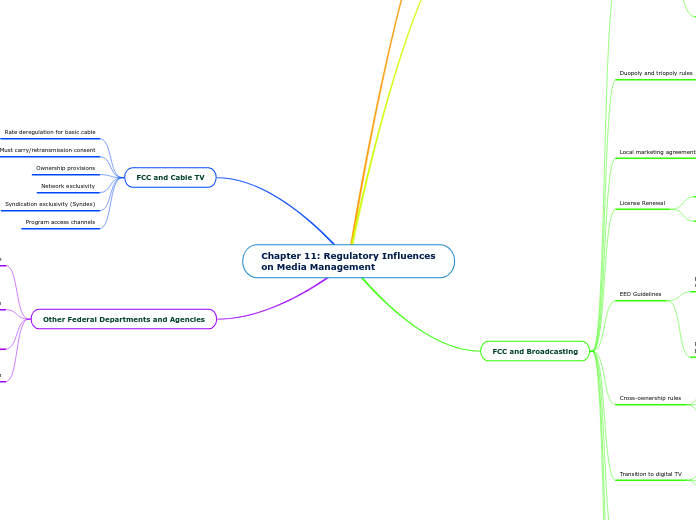Chapter 11: Regulatory Influences on Media Management
FCC’s Programming Policies
Children’s TV Programming
TV ratings system
Obscenity
Indecency
Equal time provisions
Broadcasting a hoax
Lotteries
Contests
FCC and Telecommunications Regulation
FCC and Broadcasting
Ownership limits
Limits on number of broadcast stations someone may own
1996 telecommunications act eliminated limits for radio
For local, number of radio stations owned depends on number of tv stations someone control
No individual may reach more than 39% of national audience
Duopoly and triopoly rules
No duopoly is allowed among the top 4 stations in terms of market share
2 tv stations owned by same provider is allowed provided 8 stations remained postmerger
2 TV stations owned in the same market reduces number of radio stations a provider may own
Depends on market size and number of stations
Triopoly
Ownership of 3 tv stations allowed if there is at least 18 tv stations in the market
One of 3 stations rated among the 4 highest allowed
Local marketing agreements
Allow 1 station to take over the programming and advertising sales for another station in the market without assuming ownership
Most existing LMAs would be allowed to become TV duopolies
License Renewal
Both TV and Radio licenses extended to 8 years
FCC eliminate some procedures for challenging a license renewal
EEO Guidelines
Require broadcasters and multichannel video program distributors(MVPDs or cable and satellite operators) to
Widely distribute info on full time vacancies
Provide notice of vacancies to recruitment agencies requesting notices
Engage in long term recruitment initiative to inform public about employment opportunities
Job fairs
Scholarships
Internship programs
Requires record keeping and reporting requirements related to EEO initiatives
Cross-ownership rules
Allows broadcast station to acquire cable systems
Cable operators may acquire broadcast stations but not broadcast networks
Liberalized cross ownership restrictions in regard to newspaper -TV cross ownership but limits to top 20 markets.
Transition to digital TV
Required existing analog stations to convert to digital TV transmission and move to a new digital channel
Commission has not required MVPDs to carry additional digital channels
FCC wants to reclaim 120 MHz from analog spectrum from TV broadcasters and reallocate it to wireless services
Public file
All broadcast stations must maintain certain docs and info in a file available for public inspection during regular business hours
Stations must handle phone requests for info from the public file during business hours
Operating and technical requirements
All broadcast stations must follow strict operating guidelines
License specifies channel for,
Channel for operation
Transmitter power
Hours of broadcasting
Maintenance of antenna and tower lights
Compliance of the Common alert protocols/Emergency Alert System(CAS-EAS)
Failure will result in fines for the station
V-chip requirements
Mandated that new TV receivers must be equipped with a V chip
Used in conjunction with a voluntary ratings system for TV programming
Give parents the option to block unwanted programs
FCC and Cable TV
Rate deregulation for basic cable
Must carry/retransmission consent
Ownership provisions
Network exclusivity
Syndication exclusivity (Syndex)
Program access channels
Other Federal Departments and Agencies
Department of Justice
Gauges impact of mergers and acquisitions
Concerned with anticompetitive practices
Federal Trade Commission
Advertising regulations in the US
Investigates false or deceptive advertising as well as unfair trade practices
National Telecommunications and Information Administration(NTIA)
Advises the president on telecommunications issues
Federal Aviation Administration
Potential risk to aviators due to broadcast towers
Fines broadcast stations for not properly maintaining proper lighting for towers and antennas
